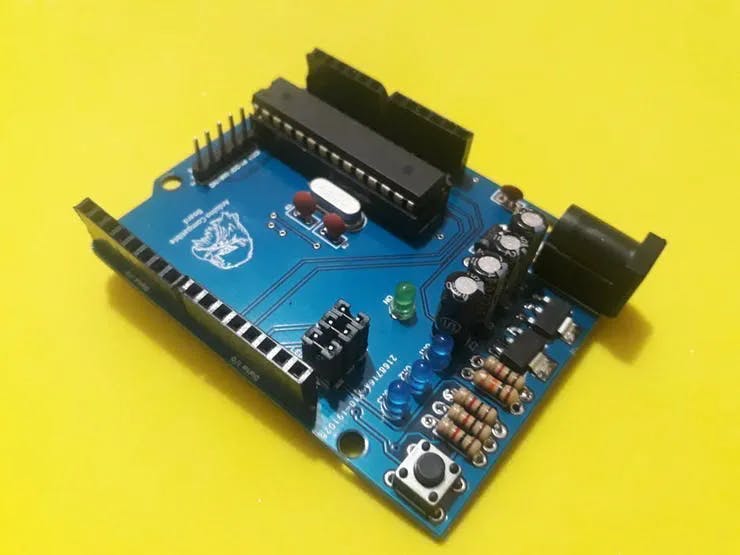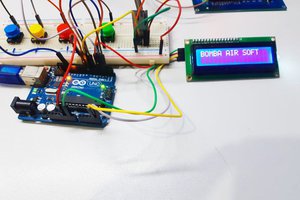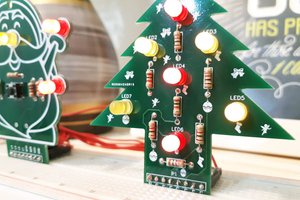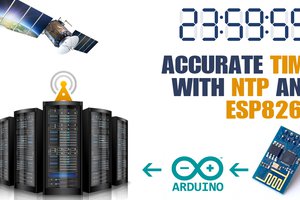For this project, we'll use the JLCPCB Arduino Compatible printed circuit board presented below.

Figure 7 - Arduino Standalone Printed Circuit Board to control the Arduino Line follower Robot.
You can obtain the Arduino JLCPCB compatible PCB for your projects for $2 in your first order with the link: Earn my PCBs Arduino Compatible.
Use the JLC-RECE coupon, earn a $2 off discount, and earn 5 PCBs.
Read the second part of this article.
Now, we'll start the project.
Airsoft is a sports game where players participate in simulations of police, military, or mere recreation with pressure weapons that shoot non-lethal plastic projectiles, often using military tactics.
It is practiced indoors or outdoors. AirSoft guns can be purchased at various online or physical stores. Have you thought about building your fake bomb for Air Soft competition using an Arduino and a radio transceiver?
This article will be divided into two parts: The first will be the pump itself, which will be the transmitter. In this pump it will be possible to configure the activation time, as well as to activate or deactivate it by means of buttons.
And the second part of the article will be the receiver that will contain the LEDs that will be activated according to the three possible conditions:
- 1st Bomb activated: The transmitter sends the L to the receiver and the yellow LED is on. Button B3 activates the pump.
- 2nd Bomb deactivated: The transmitter sends the D to the receiver and the yellow LED is turned off and the green LED is lit indicating a safe situation. Button B4 is responsible for deactivating the pump if the configured time has not elapsed.
- 3rd Bomb exploded - After the time has elapsed, the bomb is activated (Red LED and buzzer are activated).
Therefore, in this article, we will develop a fake bomb with Arduino and you will learn:
- Perform the assembly of the circuit in the protoboard;
- Understand the operation of the HC 12 module;
- Perform the communication of the Arduino with the HC 12 module;
- Reading digital inputs;
- Writing the counting time on the I2C LCD display.
Now, we will start the full presentation of the development of the fake bomb project with Arduino Uno.
Developing the Fake Bomb Project With Arduino UNO
As previously mentioned, the project consists of creating a fake bomb with Arduino Uno. The HC 12 module is a radio transceiver and its operating frequency is From 433.4 MHz to 473 MHz.
It is possible to connect two types of antennas in this module, a helical antenna that comes with the module or another antenna to be connected to the UFL connector.
These modules usually come with some factory settings, so that we can communicate 2 HC 12 modules with an Arduino Uno, Nano we need to adjust some parameters like communication speed, communication channel, operation mode using AT commands.
To configure the module, the set pin must be connected to the GND according to figure 1 for the module to enter configuration mode.
It is recommended to supply the HC 12 module with an external 5 V source, as it has some serial USB converters that do not provide enough current to supply the module.
The GND of the USB serial converter must be connected to the GND of the power supply.

Figure 1 - Schematic circuit with the serial converter connections to the HC 12 module.
Now let's go to the list of components needed to assemble the circuit in Figure 1 to perform the configuration of the HC 12 module.
Next, we will learn how to configure the HC-12 module with Termite Software.
HC-12 Module configuration process
To configure the module, we will use the Termite software. Termite Software is software that allows commands to be sent to the HC 12 module. The Arduino IDE's...
Read more »



 geekstips
geekstips